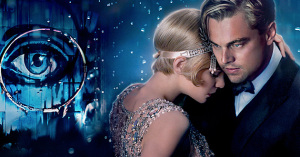Jimmie Gatz, AKA Jay Gatsby, debuted in dual-identity crime fiction long before the prototypal Bruce Wayne slipped on his Bat tights. F. Scott Fitzgerald’s The Great Gatsby rolled off the press in 1925, Detective Comics No. 27 in 1939. When Bob Kane and his writers (probably Bill Finger, possibly Gardner Fox) tacked on an origin story six issues later, they set the alleyway murder of Bruce’s parents “Some fifteen years ago.” I’m not suggesting Gatz (it’s slang for “gun”) was that homicidal thug (one of Mr. Wolfshiem’s other associates would be a better guess), but the Gatsby and Wayne funerals would have been simultaneous. Which might explain why nobody attended Gatsby’s. Though I suppose friends of the extravagantly respected Waynes would have snubbed a West Egger regardless. Thomas and Martha Wayne were tight with the Buchanan crowd.
“Jay Gatsby” is a disguise, one as elaborate as the mild-mannered reporter a certain Kryptonian invented for himself. Jimmie Gatz was born on the alien planet of smallville Minnesota. To the snobbish Nick Carraway, he might as well have crawled out of New York’s lower East Side or the swamps of Louisiana. He is a rough-neck trying to pass as an Oxford man. And, unlike Bruce and Kal-El, he’s not one of the good guys.
Jay is a party-crasher to a long tradition of gentleman thieves popular in the first decades of the century. For an origin point, see E. W. Hornung’s 1898 “A. J. Raffles,” a man of seeming wealth and leisure who secretly burgles his fellow aristocrats. Hornung was a brother-in-law of Arthur Conan Doyle, and his character is an inverted Sherlock Holmes. By 1925, the character type’s anti-heroism had mutated to Robin Hood do-goodery, the mission Kane and Finger burgled for Batman. Graham Montague Jeffries published Blackshirt the same year, another tale of a thieving yet well-intentioned well-born—this time inspired by Mussolini’s Fascists. Hitler published Mein Kampf in 1925 too, a treatise Tom Buchanan and many of his fellow East Eggers sent up the best seller list.
As far as supervillainous schemes go, the Gatz Plan for World Domination is small-fry, mostly bootlegging and stock scamming. Unless you count his secret identity itself. “Jay Gatsby” is an agent of social chaos greater than Christopher Nolan’s Joker. To Tom Buchanan, the mere existence of the new money millionaire signifies the collapse of Aryan Civilization. Soon blacks and whites will be marrying. He’s the bridge beyond which anything can happen.
But what ultimately wins Nick over to Gatsby’s belated side is his other Plan for World Domination, the wooing of Daisy Buchanan. In addition to re-inventing himself, Jay invents a time-machine more complex than Dr. Doom’s or Kang the Conqueror’s. He wants to reboot the world and repair the moment he lost Daisy. And like any Quixotic supervillain, he can’t see the futility of his own plan. Of course he’s going to fail. That’s the point.
I miss teaching The Great Gatsby. Before I re-invented myself as a college professor, Fitzgerald was a perennial high point on my high school syllabus—same as most high school syllabi. I don’t need a time machine to visualize the filmstrips from the 1974 adaptation I had to watch when I was sixteen. It’s a god awful film, the surprisingly incompetent script penned by Francis Ford Coppola. So imagine my delight when I heard Baz Luhrmann was taking a fresh shot. His Romeo and Juliet was a delightfully frenetic mess, Moulin Rouge yet more so, and so who better to capture the excesses of the decadent 20s?
True to form, Baz delivers a circus wagon of a movie. I was planning to enjoy it, but despite the incongruous hip-hop beats, it was almost as yawningly dull as last time Gatsby the Great popped into our timeline. I admit much of the problem is me. I know the book embarrassingly well, and the Luhrmann script, like the Coppola script, is a collage of favorite lines. I know, you’d think that would be a good thing—Fitzgerald’s own words!—but it means neither doggishly devoted screenplay ever commits to its own storytelling.
Worse, Luhrmann loves voiceovers. Which isn’t necessarily an absolute evil in screenwriting. But instead of visual juxtapositions or contradictions, we get lazy repetitions. Tobey Maguire narrates what we’re already seeing. He tells us that his neighbor is standing on the dock reaching for the green light. And, yep, sure enough, there’s Leonardo DiCaprio doing exactly that. It’s the definition of excess, but not the fun kind (like replacing Klipspringer’s baby grand with a church-sized organ—why not!). Early comics suffered similar redundancy. Look at the Bill Finger panel declaring Batman’s first appearance in Detective Comics 27: “As the two men leer over their conquest, they do not notice a third menacing figure behind them… It is the ‘BAT-MAN!’” And, yep, that’s exactly what Bob Kane drew in the panel under it. Comics outgrew the flaw decades ago, making poor Tobey all the more annoying now.
But maybe Baz is fulfilling a larger theme here. Gatsby has to fail. It’s what makes him Great. Ultimately, he and Bruce aren’t very different. Yes, Batman directs his megalomania for good—but just barely. His never-ending war on criminals is about vengeance and self-punishment. He’s ceaselessly borne back into his parents’ alleyway, endlessly replaying a botched past he will never get right. Gatsby’s jilting at the hands of Daisy is no different. It’s a fate he’ll never escape either.
“Can’t repeat the past?” he cried incredulously. “Why of course you can!”
I can’t wait till the next time Hollywood reboots him.

